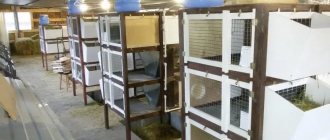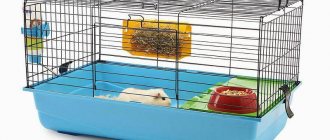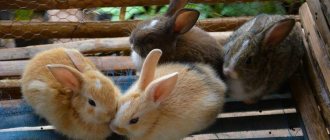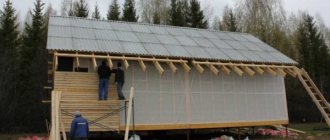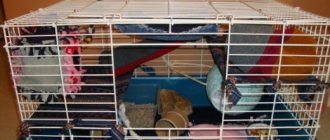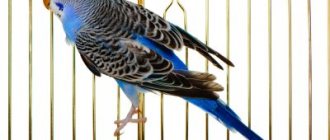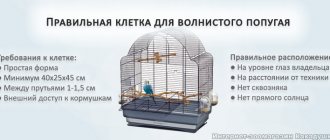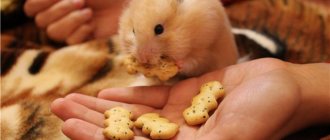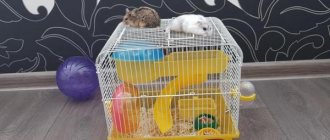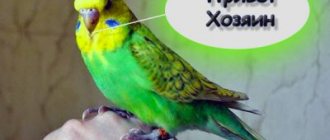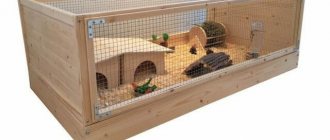The house finally has a pet bird - a parrot! Often, at the same time as purchasing a bird, you also purchase a house for the bird, but what to do if you have purchased a large parrot that still needs a large cage-aviary?
If you really want, you can make such a house yourself at home.
What should the poles be like?
When you purchase a cage, it already comes with perches.
They are made of plastic, thin and hollow inside. As a result, such crossbars become a convenient breeding ground for bedbugs and microbes. When a parrot chews on them, plastic gets into its stomach, which can kill it. Thin crossbars cause calluses on the paws. You can replace them with ready-made ones. You should choose rubber, flexible ones. The material must be free of dyes and suitable for the diameter of the bird. In addition to them, it is necessary to periodically install crossbars made of pumice - to grind off the claws. You can just buy rope ones with wire inside. In any case, you will have to trim the bird's claws. The wavy can become entangled in the threads of a chewed rope.
Perches for budgies should be:
- made from natural material;
- hard enough to drive claws in;
- diameter 12 – 18mm.
Perches must be made of natural wood
The bird's leg is designed in such a way that when it grasps a branch, the tendons are stretched, the claws dig into the surface and the parrot, without straining, can spend several hours sleeping, pecking at fruits and resting in the shade of the leaves. He makes efforts by leaving the crossbar and tearing his paws off it.
The best option to create comfort for your pet is to make perches for parrots with your own hands. To do this, you need to take straight branches from trees that are useful for birds.
- Trim branches 8–10mm longer than the width of the cage.
- Place them in a saucepan and load them so that they do not float. Boil for 20 minutes.
- Remove bark. Polish with sandpaper. The cross-section may have differences, but the diameter should be 15 - 18 mm (1.5 - 1.8 cm) for an adult budgerigar.
- Make grooves at the ends - cut with a knife to a depth of 5 - 6mm. The bars of the cage are wound into them.
There should be 2 crossbars in a cage for one parrot. One is located near the feeder. The bird will eat from it. The second one is diagonally at the top. Parrots love to climb higher. In an aviary with several birds, how many perches are installed. The rule is simple.
- The parrot should be able to freely flutter from one to another.
- There is no need to place anything like swings, bridges or other crossbars under the crossbars. It will be stained with bird feces. Birds cannot control this process.
- The perches should not confine the birds, prevent them from spreading their wings, or touching their tails.
Perches should not interfere with pets
For a young parrot, the best perches are conical ones from 8mm to 15mm. He will choose where it is more convenient for him to sit. By replacing them with new perches, you can make them even, adjusting them to the size chosen by the wavy. If the bark on the branch is smooth and clean, you don’t have to remove it, just treat it with boiling water or in the oven.
You can attach a short perch to one wall in different ways.
- At the end, mark the center for the self-tapping screw.
- Place 2 washers and partially tighten the screw.
- Insert the crossbar into the cage so that the rods are between the two washers. Tighten the screws, squeezing them and fixing the crossbar to the cage wall.
By analogy, a more durable fastening is made. Drill a hole, insert a pin with washers and tighten it with a nut.
You can make perches for parrots yourself
Acceptable Materials
Birds love to chew on perches, toys and twigs. To prevent toxic substances from entering the body, the parrot's cage must be made of safe materials.
Important: High quality stainless steel is considered the best material. It is not subject to oxidation and does not rust
Cheap house models made from materials of dubious quality threaten the health of pets. Galvanized rods can cause poisoning to a parrot. No less dangerous is copper, which quickly oxidizes. Its oxides act as a strong poison on birds.
Wooden parrot cages are only suitable for temporary housing. Budgerigars gnaw through them with ease. Wood absorbs moisture, becoming a favorable environment for the growth of bacteria.
A good option is a plastic structure. This material is non-toxic, but is susceptible to high temperatures. Therefore, houses made from it cannot be washed with hot water.
What cell color to choose
The bars of most cages are powder coated or made of stainless steel. Powder coating means that the metal is spray painted. These parrot cages can be very attractive because owners can choose a cage of any color that matches the design of the apartment and the color of the bird.
It is better to choose unpainted cells from which the paint will not peel off over time.
However, it is worth understanding that sooner or later you will notice that the paint has peeled off, and you will either need to put up with it or repaint the cage. The best choice is a stainless steel frame . Such cells are durable. However, they are also expensive. However, in the future you will spend less money on their maintenance than on a standard painted house.
Perches and swings
We don't always think about the comfort for the paws of our feathered friends. But parrots use them 24 hours a day, even when they sleep. It is best if the cage can accommodate several perches of different sizes. Natural wooden branch perches for parrots are preferable to plastic ones, because... have natural roughness. Plastic perches are too smooth and uncomfortable for the bird. In this case, the accessory can be additionally sanded to give it an uneven surface. Sisal ropes are comfortable for the bird, but you need to keep an eye on the surface so that they do not become too loose so that the parrot can hang on. You should also choose a swing from affordable and high-quality materials: a round fabric ring with a perch for a parrot. You can equip the cage with natural wood
Many owners prefer swings made of stainless steel, rubber and rings with impact-resistant plastic. If you choose rubberized products, you should make sure that the parrot does not bite or swallow pieces; If you still notice a bad habit, it is better to remove this accessory from the cage.
Varieties
Pet stores offer a huge number of toys made from various materials and designed for wavy animals. They can be used inside or outside the cage and have different functions.
Some things are needed to sharpen the beak and nails, while others develop intelligence. There must be toys designed for the full physical development of the pet.
Before purchasing a finished product, it is important to make sure that there are no glue residues or small objects on the surfaces that the parrot could tear off and swallow.
For sharpening the beak
The beak of the wavy is covered on top with a horny layer, which is easily ground off.
To do this, the parrot must have constant access to special objects that are used to sharpen its beak. You can use special toys made of wood or plastic.
The basic rule to follow is the safety of the material used. Typically, such toys are represented by a dummy bird, wooden sticks attached to the wall of the cage, as well as perches with unusual protrusions.
Intelligent
Their purpose is to develop the mental abilities of the bird. They are represented by special educational puzzles, upon solving which the bird gains access to some kind of delicacy.
Usually labyrinths or special balls are used for these purposes, which are closed on several sides, but have recesses into which the wavy can insert its beak. With regular use of such toys, the pet becomes more intelligent, and this often has a positive effect on the speed of speech learning.
Do you buy toys for your parrot?
Not really
For physical development
Since pet parrots don't move much, they require special items to help them maintain optimal physical condition. For this purpose, special rings, perches, bungees and ladders are used.
But it is not recommended to overdo it with these elements, since otherwise the parrot simply will not have room for quiet rest and relaxation. You need to place purchased or made elements at different heights.
Interactive
They consist in the fact that the bird must perform certain actions in order to receive a certain delicacy. Sometimes such toys produce sounds when pressed, which arouses the parrot's interest.
Some birds do not understand what needs to be done with an interactive toy, so the human task is to show the principle of operation of the item.
I completely forgot to tell you about the cage door
The door is quite large, 17.5 x 57.7 mm, so that you can reach any corner of the cage through it. I couldn’t find small canopies for attaching the door to fit on a 10mm square, so I decided to install the door on a d3mm pin. There is a through pin at the top so that if something happens the door can be removed.
As for the lock, I used a small bolt on a spring for these purposes. The bolt is attached to a plate located on the back of the mesh. I would like to note that there should not be any nuts inside the cage, since parrots can unscrew them, so it is necessary to cut a thread in the plate.
I decided to make the utility compartment doors sliding. For these purposes, I purchased glass runners, which are used in chipboard furniture. However, instead of glass, I used 4mm thick PVC plastic (fibreboard could have been used), because of the small child in the house.
The plastic was covered with self-adhesive film, as were the sides of the utility compartment.
Now, you can stock the household compartment with food, treats, chews and all the necessary equipment.
The cage is not yet completely ready (the only thing left to do is install the feeders and screw on the perches), so to be continued...
Added on September 10, 2015.
Fastening, how and with what to fasten
The cage structure is made of welded mesh with a wooden frame.
Regardless of the type of mesh used, the cage production process involves several steps:
- First of all, the frame is assembled; it is made of wooden blocks or metal corners. Fastening can be done with nails, screws or welding.
- The mesh, cut (with a grinder or metal scissors) into fragments of the required size, is attached to the frame using self-tapping screws.
- The mesh sheets are fixed together with staples or clips; it is possible to use wire, but this solution is not entirely safe for animals.
- The floor is formed from wooden slats or fine-mesh sheets. In the second case, the bottom still needs to be reinforced with timber elements.
- The partition (if necessary) is also secured with staples or clips.
- Make doors from timber or slats, attach awnings and latches.
- The roof is made of plywood, metal or mesh. Depending on the material of the frame and roof, it is possible to perform assembly using self-tapping screws or using welding technology.
- The pallet is made of galvanized sheet and fastened with self-tapping screws.
- The feeder and drinker are fixed with brackets.
- All connections must be strong, the structure must not have protrusions, sharp corners, or protruding parts.
To attach the mesh to the posts during the construction of enclosures and pens, knitting wire, hooks, and welding technology are used. To strengthen the chain-link, longitudinal stiffening ribs should be used to prevent the fabric from sagging. An alternative to chain-link for the construction of fences for various purposes, including in agriculture, is Manier mesh (hexagonal).
Required Tools
- Metal grid.
- Wooden board or piece of door.
- Hammer.
- A drill or screwdriver will help make the necessary holes in the bottom.
- Scissors for working with metal.
Check it out here too!
- Do-it-yourself barbecue from a gas cylinder: step-by-step instructions, choosing the optimal sizes and tips for choosing projects (110 photos)
- Do-it-yourself winter chicken coop: design, layout, insulation, heating. 80 photos of warm chicken coops
- How to make a snow blower with your own hands: manufacturing methods, diagrams, drawings, construction options and application nuances (100 photos + video)
Perches and swings
As mentioned above, you can make wooden perches yourself
But to figure out how to set up a cage for a budgie, it is very important to know what raw materials are suitable. In general, any wood can be used, except for a few varieties:
- containing toxic substances (acacia, poplar, lilac);
- which contain tannins (cherry, oak, pear);
- conifers containing resin.
You can simply use a branch that is not too thick (about 1.5–2 centimeters in diameter) - this is the easiest way. Before installing the wood in the cage, it must be doused with boiling water and wiped dry.
It is fashionable to equip the cage with natural wood
We don't always think about the comfort for the paws of our feathered friends. But parrots use them 24 hours a day, even when they sleep. It is best if the cage can accommodate several perches of different sizes. Natural wooden branch perches for parrots are preferable to plastic ones, because... have natural roughness.
Plastic perches are too smooth and uncomfortable for the bird. In this case, the accessory can be additionally sanded to give it an uneven surface. Sisal ropes are comfortable for the bird, but you need to keep an eye on the surface so that they do not become too loose so that the parrot can hang on. You should also choose a swing from affordable and high-quality materials: a round fabric ring with a perch for a parrot.
Many owners prefer swings made of stainless steel, rubber and rings with impact-resistant plastic. If you choose rubberized products, you should make sure that the parrot does not bite or swallow pieces; If you still notice a bad habit, it is better to remove this accessory from the cage.
Selection Criteria
When choosing a cage for a budgie, special attention should be paid to the distance between the fencing rods. If the parrot can squeeze its head between them, the risk of serious injury increases. Therefore, the cage must be selected taking into account the size of the bird.
Therefore, the cage must be selected taking into account the size of the bird.
If the parrot can squeeze its head between them, the risk of serious injury increases. Therefore, the cage must be selected taking into account the size of the bird.
Budgerigars are considered the smallest members of the family, so the distance between fences should not exceed 1 cm.
Many birdcage manufacturers design their products with a specific subspecies of bird in mind, which makes the choice easier.
What material should it be made of?
In the process of playing and sharpening its beak, the parrot tries to gnaw everything it comes across, including rods with a frame. Therefore, the quality component of the material from which they are made is also very important. In the poultry market you can find all-metal solutions, wooden and synthetic.
Products made from steel wire are a classic option. They do not block the light, as well as the view, are impervious to wet cleaning and withstand disinfection. In addition, all-metal cages are quite heavy and it is more difficult to accidentally knock them out with your elbow than lightweight structures.
Products made of copper should never be purchased for poultry. Upon contact with water, detergents and disinfectants, copper begins to oxidize, emitting fumes that are toxic to the pet.
You can also find wooden cages in stores. Despite the environmental component of the material, such solutions cannot be called the optimal choice. The fact is that wood absorbs literally everything, including water and disinfectant solutions. As a result, the material begins to rot, opening the door to parasites, fungus and infectious diseases.
There are combined solutions, where the frame is made of wood and the rods are made of metal. But this is also not the best option for a budgie. Even if the material is well protected from moisture by impregnation, a playful bird will chew it through in a few months.
A good alternative to all-metal products is synthetic solutions. Cages made of organic glass look original and presentable. They are also not afraid of moisture and contact with specific solutions. A significant disadvantage of synthetic products is their vulnerability to high temperatures, as well as a fire hazard.
Which form to choose
Despite the attractiveness of round and multifaceted cages, this is not the best option for an exotic pet. For example, canaries feel great in such a house, but a budgerigar will constantly experience stress due to the lack of a corner. The bird needs a place where it can hide, even if only symbolically.
The ideal shape of a house for a wavy is rectangular. According to the observations of ornithologists, it is in this design that the bird feels most comfortable. Moreover, rectangular cages can be used as modules, adding a “floor” on top if another pet appears.
Budgerigars are not helicopters; for takeoffs and flights, they need space in the horizontal plane, not the vertical.
Is it worth getting a parrot?
Not really
Optimal size and shape
Even a small bird needs ample space, otherwise the quality of life deteriorates. The cramped structure limits mobility, and the parrot is forced to sit on a perch instead of fluttering about for its own pleasure. The cage should not be the place where the parrot is imprisoned - it is his home, so before construction you need to think through all the little things.
One of the main parameters of a cage for a budgie is size. The value must correspond to the number of residents and their height:
- for a chick that has just been separated from its parents, a small temporary house is enough: length and width 25 cm, height 40 cm;
- an adult needs a more spacious cage: from 40 cm in length and width, from 50 cm in height;
- two parrots fit quite freely in a half-meter product with a height of 60 cm, and with each subsequent bird the dimensions should increase proportionally.
The larger the cage, the better for the wards, but it is problematic for the owner: the cleaning area increases, the useful volume of the room decreases.
The preferred shape of a house for a new pet is rectangular with horizontal and vertical bars. The angular design serves as a safe haven for the parrot. A timid wavy can hide in a secluded corner, away from prying eyes. Tall round cages with a dome top are designed for settled parrots and small groups.
Note: Products with fancy shapes look attractive, but they are not very convenient for cleaning.
Homemade options
Having decided on the parameters of the cage for the budgie, you can begin making it yourself. For this work you will need to acquire:
- tape measure;
- a sheet of plywood;
- pencil;
- a piece of paper;
- pliers;
- nails or screws;
- fine sandpaper;
- wood glue;
- hammer;
- wire cutters;
- metal mesh, the cells of which are 1-2 cm;
- construction stapler;
- screwdriver;
- wooden slats with a section of 2 by 5 cm in the amount of 12 pieces;
- metal profile;
- file;
- screwdriver;
- corner;
- canopies.
To make a cage measuring 0.6x0.25x0.35 meters, you should follow these steps.
- The bottom is cut out of sheet plywood in the form of a rectangle with dimensions of 0.6 by 0.25 meters.
- Along the edges of the bottom there are slats that will serve as sides.
- From the previously prepared slats, 3 pieces of small width along the length of the bottom are cut out. These elements will become grooves for the cage; they are attached to the base with glue.
- A sheet for the pallet is cut from the metal profile, the dimensions of which will allow it to fit into the grooves. The front part, bent 90 degrees, will make cleaning the cage easier.
- 8 blanks are cut out of the slats, with the help of which the mesh walls will be attached. Their length should be equal to the height of the cage.
- Using a screwdriver, holes are made into which parts of the mesh will penetrate.
- Wood blanks are coated with glue and fastened together to ultimately obtain 4 wooden corners.
- A part of the mesh is measured and cut out, which is subsequently attached using a construction stapler to the glued planks.
- Next, the top of the cell is made. Wooden slats are attached to the sides; holes must be pre-drilled in them for attaching the mesh. The same rail should be mounted in the center.
- It is worth attaching awnings to the back side, and then installing a roof for the house. One half of the roof will open, for this it will have a latch.
- It is worth cutting a hole in the front wall for future doors. According to its dimensions, a slatted frame is made, and a mesh is stretched over it. The loop and lock are made of wire.
Drawings and step-by-step assembly instructions
Make a drawing of the future bird house. At the same time, take into account the size of the parrot, behavior, favorite activities and your own preferences.
You can look for convenient and comfortable cages on the Internet, and use them to create your own version.
Remember! Metal elements must be processed so that the bird does not get hurt on them, and wooden elements are sanded.
DIY bird cage.
- According to the modular principle, the underbody, side walls and roof are first assembled separately. Then they are attached to each other.
- First, the pallet is cut out from four bars, then the bottom itself, preferably from a sheet of chipboard. It is the basis of the cell. The parts are fastened together with nails or self-tapping screws strictly outward.
- Already sized metal corners are attached to the bottom, to which the adjacent side walls made of mesh are then screwed.
- When the frame is ready, work is done to secure the roof. It is recommended to make it from solid material, to which you can attach accessories for your pet - swings, bells, mirror, etc.
- The back wall is mainly made of galvanized iron.
- It is also recommended to “put” the house on wheels to make it easier to move.
- Don't forget the hole for the hinged door.
- The component elements are assembled into one common structure.
Choosing a cage for a budgie
As practice shows, regardless of age, budgies are among the very mobile and active pets, so such a bird must be provided with a spacious, fairly high and wide cage made of high-quality and durable materials.
Correct cell shape
Currently, manufacturers have launched the production of bird cages, which differ quite greatly in shape and size. The cage can come in a round, square or traditional rectangular shape, as well as a variety of roof designs.
A feathered pet will feel best in a classic rectangular cage with a comfortable flat roof. Among other things, this cage design does not cause disorientation of the pet in space.
Optimal sizes
In order to independently correctly determine the optimal and most comfortable cage size for the bird, it is important to take into account several basic parameters:
- a bird sitting in the middle of a perch should be able to calmly spread its wings and flap them, so the width of the cage is determined individually, depending on the size of the pet;
- The length of the cage is selected so that it is possible to install a pair of perches at different heights and distances. The bird should easily flutter between the perches without touching the cage bars with its wings.
Even if the budgerigar is supposed to be let out quite often for walks indoors, the size of the cage should be comfortable for the feathered pet:
- for one bird, a cage with a length of 40 cm, a width of 25 cm and a height of 30 cm is enough;
- for a pair of birds you will need a cage 60cm long, 30cm wide and 40cm high.
For two pairs of birds, you will need a cage, the dimensions of which are 60 cm in length, 50 cm in width and 60 cm in height.
Acceptable Materials
Budgerigars love to chew not only their toys and accessories, but also the bars of their cage, so there are special requirements for the materials used to make such a home structure. The most optimal material today is high-quality stainless steel, which is not capable of rusting or oxidizing.
Short-lived cages made by unscrupulous manufacturers can be made of toxic cheap materials, including galvanized rods, which often peel off during use and become the main cause of poisoning in a budgie. The copper rods of the cage, which quickly oxidize under the influence of external factors, can also be dangerous for a feathered pet.
Cage requirements
The cage is where the parrot spends most of its time. It must have the appropriate size and shape so that the pet feels comfortable. In addition, the design and materials must be safe for birds.
Dimensions and shape
The size of the cage directly depends on the size of the parrot that will live in it. The minimum housing dimensions for small species (for example, a budgerigar) are 40x25x50 cm (LxWxH). For large individuals, a large cage or enclosure will be required. If you plan to keep several birds together, the dimensions of the housing should be increased in proportion to the number of inhabitants.
The most preferred shape is rectangular. It is convenient to design and assemble, and later to clean and equip with the necessary accessories. You can make a cylindrical cage, but it must be larger than a rectangular one.
Material of manufacture
The roof, walls and door are made of rigid mesh fabric, for example, construction welded steel mesh with a wire thickness of 2-3 mm. Larger species of parrots will require a thicker, stronger guard. The distance between the rods for small birds should not exceed 1-1.5 cm, for large birds - 2 cm.
The bottom is made solid; For ease of cleaning, it is advisable to make a retractable tray. It will require a sheet of plywood 1-1.5 cm thick. To prevent debris in the form of food particles from accumulating around the cage, a side about 10 cm high is installed around the perimeter of the bottom.
Where are the best places in the house for birds?
Before buying a budgie, you need to decide on the room where to put the cage with the parrot and where the budgie will live.
Here you should be guided by the fact that parrots are quite active and sociable birds that need constant interaction with their owner. In this regard, the most preferred room in the house may be the one where family members spend the most time.
This is, first of all, a living room. This is where all family members meet and spend time together. Thus, being in the living room, the feathered pet will not feel alone.
Does a parrot bother you at night?
Not really
Also, if for one reason or another it is not possible to place the cage in the living room, the bedroom would be a good place to place it in the house. As a rule, the owner spends quite a lot of time in the bedroom, and here, as a rule, there is a quiet and calm environment where the parrot will not be disturbed by external stimuli.
If the owner has a personal office in the house where he spends a lot of time working, then it is quite possible to place a cage with a feathered pet there.
In general, when choosing a room to place a cage there, the owner must take into account that this room must be fully suitable for the pet’s living conditions. There should be no drafts here, but it is desirable that normal air temperature and humidity be maintained.
Despite the fact that parrots need communication with people, birds do not tolerate excessive attention, especially from strangers. That is why you should choose a room where it is relatively quiet and calm.
In general, the best place for a cage in the house is where the parrot will feel comfortable
In general, the best place for a cage in the house is somewhere where your parrot will feel comfortable.
Why a good cage is important
You're probably familiar with the story where one guy realizes his dream and buys himself a hyacinth macaw, but he doesn't have enough money to buy a cage, and he puts the parrot in the wrong box or a cage intended for another animal. While the owner is at work, the parrot destroys the cage and begins to damage furniture and other interior items. Don't repeat his mistakes!
A large parrot needs a cage with thick bars
If you love a pet, you will probably want the best for it, let's figure out what a parrot should have in its cage.
Step-by-step creation of a cell
To understand how to make a parrot cage yourself, we recommend that you read the advice of people who did it themselves at home.
The mesh should be leveled and special blanks should be cut. For cutting, you can use special scissors for working with metal or a grinder.
The next step is to drill holes in the bottom where the lower edge of the grille will be inserted. They should be folded from below.
An important nuance - all markings should be made based on the grid, and not under the ruler. This will avoid errors in the distance between cells in the grid.
We continue to assemble the cage, not forgetting to bend all open rods near the rods of adjacent panels. Try not to create any internal folds.
Despite the fact that at first glance the structure itself will look a little fragile, in the end it will delight you with its strength.
This instruction is also suitable for understanding how to make a cage for a Corella parrot
It is very important to take correct measurements and determine in advance what size cage you need.
To prevent the opposite sides from “moving”, secure them with poles. The sticks for the perch should be selected so that your bird can wrap its paws around it. That is, focus on the size of your paw.
The final touches are to attach the bird swing to the ceiling panel. You can make a small trough from plywood where the bedding will be placed.
If you are planning to breed parrots and immediately purchased a couple, you should think about how to make a nest for parrots in a cage.
Remember that they need an enclosed house where the female can lay her eggs. No one should look into the nest prematurely, so as not to disturb the young female and allow her to calmly take care of her future offspring.
What's important to your bird
In order for your parrot to be quite easy and comfortable, you need to think in advance about the availability of free space for its flights in captivity.
It is equally important to have your own play area for the bird. You can also watch a video on how to make a cage for a parrot in order to understand what should be inside your bird’s home.
Let's say you decide to purchase the most common breed of parrots - a budgie. This species is very friendly and is always ready to please its owners with joyful and lively communication.
However, for this it is necessary that the bird feels comfortable. The optimal cage size for a budgie is 75x100x120 (h).
You can purchase or make a larger cage, which will allow the bird to fly freely inside the cage. Video instructions or diagrams for building houses for domestic birds will tell you how to make a cage for budgies.We recommend purchasing cages that are equipped with trays. This will allow you to clean the inside of the cage as quickly and efficiently as possible and will not spread an unpleasant odor around.
Read here - Do-it-yourself trolley - how and from what to build a decorative and tool trolley (135 photos and videos)
A suitable place for a cage in an apartment
When considering the appearance of a good cage, you need to take into account its future location. Here are the places where you definitely shouldn’t put it:
- on the windowsill;
- on the floor;
- in indoor plants;
- next to the heating radiator;
- on the refrigerator.
The kitchen is not the best place for a parrot. There are noisy household appliances, the heat from cooking food, the sound of pouring water. Parrots will not be able to get proper sleep. In a nursery or bedroom, on the contrary, the owners will be deprived of a peaceful rest because of the birds' cooing. It is optimal to place the cage in a room where family members often visit during the day and no one at night. For example, in the living room. It is not at all necessary to stay close for a long time; it is enough that the birds observe and sense people nearby.
placing your parrot's house on the floor or near the TV is unacceptable; It is considered normal not to hang the cage from the ceiling or wall, but to place it on a horizontal surface: a bedside table, a table, a closet shelf; The house should not be pushed into the far corner, but it is also not advisable to place it in the middle of the room
It is important for parrots to feel protected and at peace; one side of the enclosure should be directed along the wall, the other should be facing the light source; You need to protect parrots from direct sunlight by shading part of the grille.
Where to put a parrot cage
The best place for a parrot is where its owner will always be nearby. In modern conditions, this is complicated by the fact that there is a table with a computer next to it, near which it is not advisable to place the cage. TV, radio, speakers from a music center are sources of sounds that will irritate the bird.
The place should be bright, but without direct sunlight. It is best if this is a place against the wall near the window, but not in a draft. Walls give the parrot a feeling of security. The bird will always know that there is no threat to be expected from one side.
The windowsill is no place for a bird, even if the sun's rays do not reach there. In winter, this is the coldest place; in the off-season, the temperature difference is most felt on the windowsills.
You cannot set up a place for a parrot near a heating radiator, under an air conditioner; it will overheat or get burned.
If a fan is turned on in the room, it is necessary to ensure that the air wave does not reach the bird. It is enough for a parrot to stay under such a stream for 15 minutes to catch a cold.
If the owner (hostess) spends most of his time in the kitchen, there is no need to place the parrot there. It is better to place it in another room so that the pet has a door leading to the kitchen within sight. Constantly breathing fumes from cooking food is very harmful for birds; this can lead to the development of bronchopulmonary diseases.
Suspending the structure from the ceiling is not the best option. She may not be able to stand it and fall. The parrot is unlikely to like the feeling of instability. Pallets have a habit of falling off at the most inopportune moment. To eliminate all these risks, the cage is placed on a sturdy stand.
It is cruel to place a dwelling with a parrot on the floor, since the parrot will have a limited viewing angle.
The stand for the cage must be strong and stable. If the cage turns over, the parrot will not die, but it will be very frightened. Stress negatively affects the health of birds. There have been cases when talking parrots stopped pronouncing learned words after being frightened.
How to properly arrange a home for a parrot?
Everything necessary for the bird is placed in the bird’s home:
- Separate feeders for dry and succulent food, vitamins. Dry food (grains, granules) should always be present, fruits and vegetables should be added 2-3 times a day.
- The drinking bowl must be automatic so that the water does not become polluted. You can buy it ready-made or make it yourself.
- Perches with a diameter of 15 mm for resting and eating, near feeders. The wood does not need to be polished; the bird needs roughness for a strong grip.
- There should be a lot of toys, but they should not interfere with the feathered owner of the home moving around his apartment.
- Bathing container. Parrots splash with pleasure, especially in the heat. A metal deep cup is used as a pool, which is well fixed.
- Mineral (chalk) stone. When the bird chews it off, they put in a new one. If there is a lack of calcium in the pet’s body, the beak and claws begin to separate, and the joints weaken.
Sometimes parrots bring “treasures” into their home: things that they liked while walking around the apartment. More often this happens when the parrot has few toys and is not given enough attention.
Feeder and drinker for a parrot
These two accessories are essential parts of any parrot cage. If the size of the cage allows, then it is best to use three feeders for parrots: a water bowl, a bowl for dry foods (for example, grains), and a feeder for wet foods (for example, vegetables). Food bowls come in a variety of materials. Parrot feeders made of high-impact plastic, ceramic or stainless steel are safe to feed, but it is best to avoid galvanized metal bowls due to the potential for heavy metal toxicity.
Feeder and drinker
Parrots should always have access to clean, filtered water. Quite often, large parrots, such as Amazons, confuse the water bowl with the toilet, so you need to change the water several times a day. For such parrots, he recommends purchasing bowls with a “hood” or installing special closed drinking bowls , as in the photo. Such drinking bowls for parrots, despite the fact that they do not appear to be dirty, require changing the water at least once a day.
Video: automatic feeder for parrots
For large cages, many owners buy a special mesh stand . You can periodically place slices of vegetables on such a grid: corn, carrots, cherry tomatoes, broccoli; pea pod. Green beans, an orange slice, a slice of banana, Brussels sprouts, pieces of sweet potato, zucchini - all this will certainly find its use.
Of course, more treats end up at the bottom of the cage, but still the parrot spends time with pleasure and eats those pieces that it considers necessary.
Accessories in a budgie's cage
The cage must not only be placed in the right place, but also equipped with all the necessary accessories.
The budgie's home should have:
- feeder;
- swimsuit;
- drinking bowl;
- perches and twigs;
- toys: swings, bell, mirror;
- chalk or pumice to sharpen the beak.
The materials must be of high quality and comfortable for the pet.
Feeders and drinkers
Feeders must be made of high-quality and environmentally friendly material. It is believed that the optimal container for food and water for a budgie is porcelain or glazed ceramic.
However, many owners neglect this requirement and buy plastic bowls into which they pour the grain mixture and pour water. In fact, this is not critical, but if you have plastic dishes, you need to be very careful about keeping them clean. Plaque and dirt can poison the food and cause adverse health consequences for your feathered friend.
Don’t chase newfangled feeders that automatically feed the feed mixture. All this, of course, is convenient and in some cases appropriate, but is not suitable for daily use. Often, wavy animals flatly refuse to eat from an automatic device, even when very hungry.
Perches
The quality of the perches in the cage is the key to the health of the bird. Since the lifestyle of budgies involves spending a long time on their feet, make sure that the perches are of the correct diameter and made of good material.
The material from which the additives should be made is, of course, wood. Plastic ones rub the soles of the paws a lot, which can lead to painful calluses. Do not buy perches from pet stores that are wrapped in sandpaper to grind down the claws; this can seriously injure your parrots' paws.
Wooden perches cannot be made from the following species:
- acacia;
- oak, pear, bird cherry (contain tannins);
- conifers (resin);
- coffee tree (caffeine);
- poplar (toxic);
- lilac.
Toys
Wavys are very curious and playful birds. They need to constantly be busy with something, otherwise they will become sad.
Toys are very important for them, but we will give you a few rules, guided by which you can choose a good and safe thing to play with.
Do not buy toys that are painted with paint, as it may contain a number of toxic substances. Carefully inspect toys, especially soft ones, rope ones, for the presence of sharp elements in them, which could injure the wavy. Plastic toys for wavy animals are short-lived
In addition, plastic may contain substances that are harmful to health. Be careful with all kinds of chains, as the links can seriously injure the bird's paws or claws. The most common toy is a mirror. Whether to install it or not is up to you
There is an opinion that with a mirror in a cage, a parrot is unlikely to speak, since all his forces will be directed to communicating with the reflection in the mirror
Whether to install it or not is up to you. There is an opinion that with a mirror in a cage, a parrot is unlikely to speak, since all his forces will be directed to communicating with the reflection in the mirror
The most common toy is a mirror. Whether to install it or not is up to you. There is an opinion that with a mirror in a cage, a parrot is unlikely to speak, since all his forces will be directed to communicating with the reflection in the mirror.
Cell prices
Prices for cages for parrots, as a rule, depend on its configuration, however, for the most part, everything that your pet needs can be done with your own hands. Therefore, we do not recommend taking a stocked house with a lot of different toys. You will still have to buy more of them to add variety to your bird’s life.
The main thing you need to pay attention to is the material from which the cage is made. Let it be a simple aluminum wire cage of a regular shape. And you can either make all the other additives for your pet’s cage with your own hands or purchase them separately.
We wish your parrot a comfortable stay in his home!
